
Mold spores are present everywhere in our environment. But with a little bit of effort you can keep household mold in its place – out of your home.
Indoors, mold grows best where moisture levels and humidity are high, such as in bathrooms and basements and on ceilings and walls where water from leaking pipes, roofs, or windows can accumulate.
A thorough cleaning with bleach and water will remove household mold, but to prevent its reappearance you needs to eliminate the source of the moisture.
Homeowner insurance policies generally don’t cover repairs for mold damage (or rot and insect infestation, for that matter). Standard policies provide coverage for disasters that are sudden and accidental but don’t cover the cost of cleaning and maintaining a home.
Once exception: If mold is the result of a covered incident, such as a burst pipe, insurance may pay for the cost of eliminating the mold.
According to the Centers for Disease Control and Prevention (CDC), most molds pose no serious threat to humans, although certain molds can produce hay fever‐like allergic symptoms, and those with asthma, allergies and other breathing conditions may be more sensitive to mold.
What about “toxic” black mold? The CDC says the term is not accurate and there is scant evidence that “toxigenic molds” found inside homes cause dangerous health conditions. The agency says hazards from such molds “should be considered the same as other common molds which can grow in your house.”
Soap and water or commercial products can clean moldy walls, floors, and ceilings, but the CDC recommends a solution of one cup of bleach in a gallon of water to kill the spores and prevent their return.
To help prevent the growth of mold in your home, the CDC recommends the following steps:
- Keep humidity levels as low as you can — no higher than 50 percent — all day long. An air conditioner or dehumidifier will help keep the level low.
- Be sure your home has enough ventilation. Use exhaust fans that vent outside your home in the kitchen and bathroom. Make sure your clothes dryer vents outside your home.
- Fix any leaks in your home’s roof, walls, or plumbing so mold does not have moisture to grow.
- Clean up and dry out your home thoroughly and quickly (within 24 to 48 hours) after flooding.
- Add mold inhibitors to paints before painting.
- Clean bathrooms with mold-killing products.
- Remove or replace carpets and upholstery that have been soaked and cannot be dried promptly. Consider not using carpet in rooms or areas like bathrooms or basements that may have a lot of moisture.
For more information on mold and moisture in homes, the U.S. Environmental Protection Agency has a useful online guide with information on what causes mold growth and how to get rid of it, actions to reduce humidity and prevent water condensation, and how to test for mold.
Also, ProInsurance, a Bay Area brokerage and insurance partner with Pacific Union, has two pages of tips on protecting your home from mold.
(Mop and bucket photo courtesy of Cogdogblog, via Flickr.)
